| Copaifera officinalis | |
|---|---|
 | |
| Botanical illustration | |
 | |
| Copaifera officinalis oleoresin | |
| Scientific classification | |
| Kingdom: | Plantae |
| Clade: | Tracheophytes |
| Clade: | Angiosperms |
| Clade: | Eudicots |
| Clade: | Rosids |
| Order: | Fabales |
| Family: | Fabaceae |
| Genus: | Copaifera |
| Species: | C. officinalis |
| Binomial name | |
| Copaifera officinalis | |
| Synonyms [1] | |
List
| |
Copaifera officinalis, the copaiba balsam, is a species of flowering plant in the family Fabaceae, native to Bolivia, Brazil, and Venezuela. [2] [1] It has been introduced to Cuba, the Dominican Republic, Trinidad and Tobago, Sierra Leone, India, and Sri Lanka. [1] Like other members of its genus, its trunks are tapped for its oleoresin, sometimes termed balsam of copaiba or, when refined, copaiba oil, which has industrial, artisanal, and medicinal purposes. [2] Its oleoresin exhibits better bactericidal activity against common pathogens than that of Copaifera langsdorffii . [3]